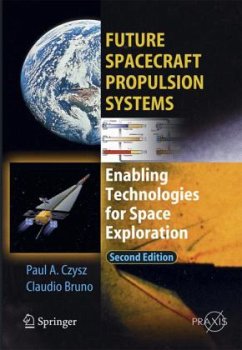In this second edition of Future Spacecraft Propulsion Systems, the authors demonstrate the need to break free from the old established concepts of expendable rockets, using chemical propulsion, and to develop new breeds of launch vehicle capable of both launching payloads into orbit at a dramatically reduced cost and for sustained operations in low-Earth orbit. The next steps to establishing a permanent presence in the Solar System beyond Earth are the commercialisation of sustained operations on the Moon and the development of advanced nuclear or high-energy space propulsion systems for Solar System exploration out to the boundary of interstellar space.
In the future, high-energy particle research facilities may one day yield a very high-energy propulsion system that will take us to the nearby stars, or even beyond. Space is not quiet: it is a continuous series of nuclear explosions that provide the material for new star systems to form and provide the challenge to explore. This book provides an assessment of the industrial capability required to construct and operate the necessary spacecraft. Time and distance communication and control limitations impose robotic constraints. Space environments restrict human sustained presence and put high demands on electronic, control and materials systems.
This comprehensive and authoritative book puts spacecraft propulsion systems in perspective, from earth orbit launchers to astronomical/space exploration vehicles. It includes new material on fusion propulsion, new figures and updates and expands the information given in the first edition.
In the future, high-energy particle research facilities may one day yield a very high-energy propulsion system that will take us to the nearby stars, or even beyond. Space is not quiet: it is a continuous series of nuclear explosions that provide the material for new star systems to form and provide the challenge to explore. This book provides an assessment of the industrial capability required to construct and operate the necessary spacecraft. Time and distance communication and control limitations impose robotic constraints. Space environments restrict human sustained presence and put high demands on electronic, control and materials systems.
This comprehensive and authoritative book puts spacecraft propulsion systems in perspective, from earth orbit launchers to astronomical/space exploration vehicles. It includes new material on fusion propulsion, new figures and updates and expands the information given in the first edition.
"Book is interesting in both the technical details and overviews but also in the theoretical parts where it for example explores Special Relativity and the nature of time ... . an excellent and very useful book when you're interested in technology and physics, or when you want to find out more about some of the ideas that modern science fiction books and movies use. It's also a great first longer introduction into some specific propulsion methods and proposed spacecraft designs." (AstroMadness.com, October, 2016)
"Authors discuss the main characteristics, advantages, and disadvantages of different spacecraft-propulsion systems, ranging from launchers designed to reach Earth orbit to deep-space probes and interstellar explorers. ... describes in detail the shortcomings of current systems and the requirement to develop new, low-cost launch vehicles and space tugs that are capable of conducting sustained operations in low Earth orbit. ... Aimed at a technically literate readership, the book is particularly thorough in dealing with the potential and drawbacks associated with various types of nuclear propulsion." (Peter Bond, The Observatory, Vol. 130 (1214), June, 2010)
"It discusses concepts and designs for the propulsion of future spacecraft which are capable of exploring the solar system and to travel beyond. ... The book is generally well-written ... . It is well-referenced, includes many figures (and a colour section) and is logically structured in nine sections and two appendices. ... The typical reader of this book is an engineer working on the field or related topics ... . a valuable reference for experts on the field and those who want to become one." (Manuel Vogei, Contemporary Physics, Vol. 51 (6), 2010)
"Authors discuss the main characteristics, advantages, and disadvantages of different spacecraft-propulsion systems, ranging from launchers designed to reach Earth orbit to deep-space probes and interstellar explorers. ... describes in detail the shortcomings of current systems and the requirement to develop new, low-cost launch vehicles and space tugs that are capable of conducting sustained operations in low Earth orbit. ... Aimed at a technically literate readership, the book is particularly thorough in dealing with the potential and drawbacks associated with various types of nuclear propulsion." (Peter Bond, The Observatory, Vol. 130 (1214), June, 2010)
"It discusses concepts and designs for the propulsion of future spacecraft which are capable of exploring the solar system and to travel beyond. ... The book is generally well-written ... . It is well-referenced, includes many figures (and a colour section) and is logically structured in nine sections and two appendices. ... The typical reader of this book is an engineer working on the field or related topics ... . a valuable reference for experts on the field and those who want to become one." (Manuel Vogei, Contemporary Physics, Vol. 51 (6), 2010)

